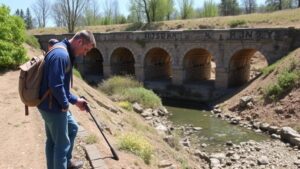Detecting for Treasure in Historic Orchard and Vineyard Estates
Detecting for Treasure in Historic Orchard and Vineyard Estates
The pursuit of treasure within historic orchard and vineyard estates offers a captivating intersection of history, archaeology, and recreational metal detecting. These estates, often steeped in rich narratives spanning generations, not only yield fruits but may also conceal artifacts that speak to their storied pasts. This article explores the methodologies, findings, and implications of treasure detection in these unique environments, presenting a thorough analysis aimed at enthusiasts and professionals alike.
The Historical Significance of Orchards and Vineyards
Orchards and vineyards have been integral to civilization since ancient times. For example, vineyards played a fundamental role in the economy and culture of ancient Rome, with evidence of winemaking dating back to 6000 BC in the Zagros Mountains of Iran. As these agricultural practices spread across Europe and the Americas, they often served as sites for social gatherings, barter, and even conflict, creating a rich tapestry of historical activity.
According to the USDA, there were over 100,000 acres of grape vineyards in the United States as of 2020, many of which have long histories. This prevalence indicates that there are likely numerous hidden artifacts ranging from farming tools to personal belongings that could provide insights into historical agricultural practices.
Methodologies for Detection
Metal detecting in these estates requires methodological rigor and respect for historical preservation. following are common methods utilized by detectorists:
- Research and Permission Seeking: Before undertaking any detecting activities, its crucial to research the estates history and seek permission from the landowners. Historical maps, local records, and archives can provide clues about significant events that may have occurred on or near the property.
- Using Appropriate Equipment: Selecting the right metal detector based on the soil conditions and what one hopes to uncover is vital. Multi-frequency detectors, for instance, can penetrate diverse soil types and identify a range of metals.
- Grid System Layout: Employing a grid system helps to methodically cover the area, ensuring that no sections are overlooked. This systematic approach increases the likelihood of locating artifacts.
Understanding Soil Types and Their Impact on Detection
The type of soil in which detecting occurs can significantly affect outcomes. Sandy soils, for example, are often easier for detecting as they allow signals from metal objects to travel more freely due to lower mineralization. In contrast, clay soils can inhibit signals, making findings more challenging.
A common analogy here is that detecting in sandy soil is akin to trying to listen for whispers in a quiet room, whereas detecting in clay soil resembles trying to hear in a bustling crowd. signals may be present, but external noise can complicate their detection.
Case Studies of Successful Finds
Several noteworthy discoveries have emerged from historic orchards and vineyards. For example, a detectorist in California uncovered a series of vintage coins dated back to the Gold Rush while exploring the remnants of an old winery. This discovery not only provided insight into the economic activities of the period but also sparked local interest in the estate’s heritage.
Another case involved the detection of Civil War-era relics in a Virginia orchard, where artifacts like buttons, musket balls, and farming tools were found. Such finds highlight the intersection of agriculture and historical events, reinforcing the importance of these sites as repositories of culture and history.
Legal and Ethical Considerations
Detecting for treasure in old estates does not come without responsibilities. Legal considerations, including local laws regarding metal detection, ownership rights of discovered items, and preservation guidelines, must always be adhered to. In the United States, the Archaeological Resources Protection Act (ARPA) governs where and how archaeological treasures may be unearthed.
Ethical metal detecting practices include:
- Reporting significant finds to local historical societies
- Practicing responsible digging and minimizing site disturbance
- Respecting private property rights and engaging with the community
Implications for Historical Research
The process of detecting treasure in historical orchards and vineyards can significantly contribute to the fields of archaeology and local history. artifacts retrieved from these sites provide invaluable data on past agricultural practices, trade, and cultural exchanges. Plus, they enrich community narratives, fostering a stronger sense of local identity and pride.
Actionable Takeaways
For those interested in exploring this rewarding pursuit, the following steps can enhance the experience:
- Conduct thorough historical research on the chosen estate.
- Obtain permissions and cooperate with local historical societies.
- Select the right detecting equipment suited for the environment.
- Be mindful of laws and ethical considerations while detecting.
- Document and report any significant finds to contribute to historical records.
Engaging with historic orchard and vineyard estates through treasure detection not only promises the thrill of discovery but also serves as a bridge to the past, allowing contemporary enthusiasts to play a part in unearthing the stories that have shaped our history.



